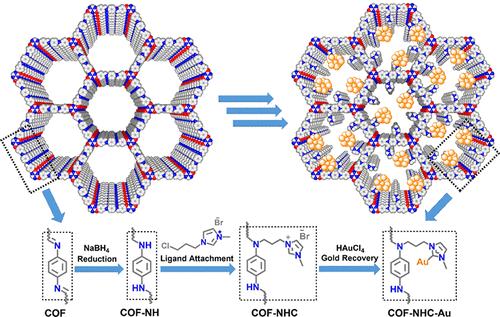nhc接枝COFs在电子垃圾中选择性金回收中的分层设计:实验和MD分析
IF 15.6
1区 化学
Q1 CHEMISTRY, MULTIDISCIPLINARY
引用次数: 0
摘要
本研究通过希夫碱缩合合成了一种高结晶亚胺连接的共价有机骨架(COF),然后通过合成后修饰(PSM)引入n -杂环碳(NHC)配体。两步PSM包括将亚胺键还原为仲胺和随后的NHCs共价连接,同时保持COF的结晶度和孔隙度。结构分析证实了改性COF的成功功能化和高稳定性。nhc功能化的COF对Au离子具有很强的亲和性和高选择性,是一种很有前途的从复杂电子垃圾基质中高效回收金的吸附剂。XPS分析证实了Au(III)离子的选择性吸附,并通过NHC位点的电子捐赠将其还原为Au(I),从而通过COF基质内的配位相互作用实现了从溶液中高效和选择性的吸收。吸附分析表明,COF-NHC对Au(III)的吸附符合PSO-Freundlich模型,具有快速吸附动力学和非均相表面结合的特点。分子动力学模拟表明,合成后改性COF中的碳官能团在稳定和潜在还原金离子方面起着至关重要的作用,强调了该框架在从电子垃圾中选择性回收金方面的有效性。本文章由计算机程序翻译,如有差异,请以英文原文为准。

Hierarchical Design of COFs via NHC-Grafting for Selective Gold Recovery from E-Waste: Experimental and MD Analyses
In this study, a highly crystalline imine-linked covalent organic framework (COF) was synthesized via Schiff base condensation, followed by postsynthetic modification (PSM) to introduce N-heterocyclic carbene (NHC) ligands. The two-step PSM involved reduction of imine bonds to secondary amines and the subsequent covalent attachment of NHCs, while preserving the COF’s crystallinity and porosity. Structural analyses confirmed successful functionalization and high stability of the modified COF. The resulting NHC-functionalized COF demonstrated strong affinity and high selectivity toward Au ions, making it a promising adsorbent for efficient gold recovery from complex e-waste matrices. XPS analysis confirmed the selective adsorption of Au(III) ions and their reduction to Au(I) via electron donation from NHC sites, enabling efficient and selective uptake from solution through coordination interactions within the COF matrix. Adsorption analysis demonstrated that Au(III) uptake by COF–NHC follows a PSO-Freundlich model, characterized by rapid adsorption kinetics and heterogeneous surface binding. Molecular dynamics simulations revealed that carbon functional groups within the postsynthetically modified COF play a crucial role in stabilizing and potentially reducing gold ions, underscoring the framework’s effectiveness for selective gold recovery from e-waste.
求助全文
通过发布文献求助,成功后即可免费获取论文全文。
去求助
来源期刊
CiteScore
24.40
自引率
6.00%
发文量
2398
审稿时长
1.6 months
期刊介绍:
The flagship journal of the American Chemical Society, known as the Journal of the American Chemical Society (JACS), has been a prestigious publication since its establishment in 1879. It holds a preeminent position in the field of chemistry and related interdisciplinary sciences. JACS is committed to disseminating cutting-edge research papers, covering a wide range of topics, and encompasses approximately 19,000 pages of Articles, Communications, and Perspectives annually. With a weekly publication frequency, JACS plays a vital role in advancing the field of chemistry by providing essential research.

 求助内容:
求助内容: 应助结果提醒方式:
应助结果提醒方式:


